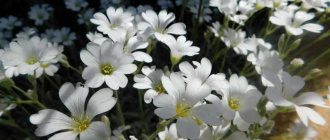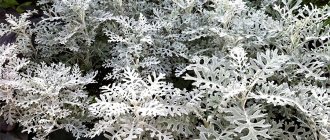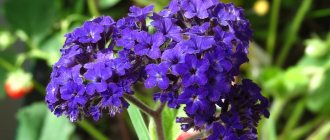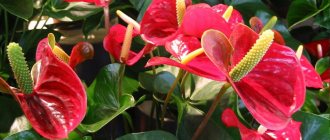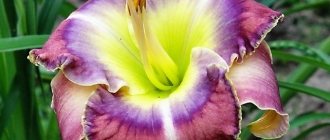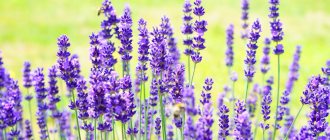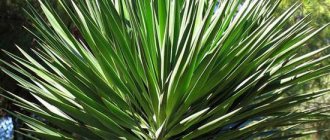Botanical description of the plant
Physalis - what is it? Berry or flower? This is a vegetable belonging to the nightshade family, a close relative of tomatoes. The plant is highly decorative and has a range of useful and medicinal qualities.
South and Central America is considered to be the homeland of “common physalis”. Found everywhere in Turkey, Iran, Central Asian countries, Bulgaria, India, and China. Here the plant is cultivated on an industrial scale. The reason for this popularity is the original taste, reminiscent of a mixture of pineapple and strawberries.
The height of the plant reaches 0.5-1 meters. The erect stems are randomly intertwined with each other, although they can be inclined towards the ground. The leaves are elongated and serrated along the edges. Single flowers grow directly on the stems. There may be 100 pieces or more. Immediately after flowering begins, the petals are colored green. After 1.5-2 months they acquire an orange or cream color.
In the depths of the flower a green fruit is born. During the ripening process, its color changes from green to lilac or red. The finished physalis berry has a sweet and sour taste with a slight bitter aftertaste.
Description
Physalis vulgaris A perennial herbaceous plant of the Solanaceae family, 30-60 to 120 cm high.
The stem is straight or creeping, branched.
The lower leaves are alternate, the upper leaves are opposite, ovoid, sometimes pubescent, located on petioles.
Blooms in May - June. The flowers are solitary, located in the axils of the upper leaves. The flowers are greenish-yellow in color.
The fruit is up to 5 cm in diameter, an orange-red spherical berry, covered with a calyx that has grown again in the form of a bubble and is colored fiery red. The fruit contains many seeds. Ripens in August - September. The surface of the fruit is sticky.
Spreading
Physalis vulgaris grows in the European part of Russia, the Far East, the North Caucasus, Transcaucasia and Central Asia. It is found in light forests, among shady bushes, near populated areas, as well as along the roadsides, fields and vineyards. In the southern regions of our country it forms continuous thickets. It has been cultivated in Europe for more than two centuries. Physalis is especially widespread in France, where it is used as a raw material for confectionery products. It grows wild in Mexico and Guatemala. In our country it grows as a weed in the south of Ukraine and the Black Sea coast of the Caucasus. In the Stavropol region, Mexican physalis grows in forests.
A little about physalis varieties
The Solanaceae family includes more than a hundred varieties of “common physalis”, which are divided into types: food (edible) and decorative.
Food Physalis
The edible fruits of physalis are consumed fresh, added to marinades, sauces prepared, dried, and canned. The juice is squeezed out of them and used as a seasoning for dishes. Dried fruits make amazing cake decorations. The pectin content in berries allows them to be used as gelatin for homemade preparations.
Food types are divided into groups: vegetable and berry.
Vegetable physalis is of Mexican origin. This is where its name “Mexican tomato” comes from. Large (50-150 grams) and juicy fruits are similar to tomatoes. The plant is high-yielding, unpretentious. Grows in the middle and southern regions of Russia. Loves soils rich in humus. Blooms in May-June. Ripens in August-September. The plant is perennial, but freezes to death in cold regions. Fresh berries are stored all winter. To do this, you need to leave the petals on the fruit.
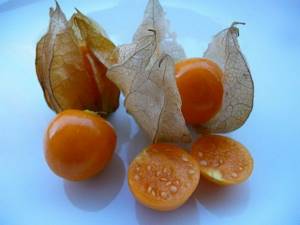
Physalis berry is native to South America. The fruit is small in size. When fresh, its weight is only 2-3 grams. There is almost no juice in the berry. It has an excellent taste due to its high sugar content: 3.92 grams per 100 grams of product. The berries make excellent raisins, which are used in compotes, marmalades, candied fruits, and candies. Dried physalis fruits retain all their properties and can be stored for a year.
Physalis berry did not take root in Russia due to the need to grow it in greenhouses, where all the places are occupied by tomatoes. It is cultivated only in amateur gardens.
Before using fresh berries, you should first clean them of poisonous petals, then pour boiling water over them to wash off the sticky coating.
Nutritional value of physalis berries (per 100 grams of product): proteins - 2 grams, fats - 0.6 grams, carbohydrates - 11.3 grams. Calorie content - 35 kcal.
Such a low calorie content makes it possible to use physalis berries for people on a low-calorie diet.
Decorative physalis
Ornamental physalis is cultivated as a flower and grown on calcareous soils throughout Russia. Absolutely unpretentious! After freezing, it grows back from the roots. The plant is especially beautiful in late autumn. Bright orange inflorescences are clearly visible among the falling asleep garden. Physalis will decorate any bouquet. And in dry compositions he has no equal at all! The fruit is only 0.5-1 centimeters in size. It cannot be used as food or as a medicinal raw material due to its high alkaloid content.
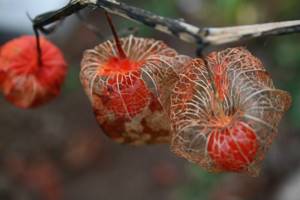
Decorative physalis. Cultivation and use
Ornamental physalis is common both in suburban areas and in city yards - it is such an unpretentious plant that it grows without special care and in any weather conditions. It is frost-resistant, undemanding to soil, so it can often be found in abandoned gardens. The crop is valued for its decorative flowers, which become especially attractive when dried.
Is it possible to eat decorative physalis?
Decorative physalis, or as it is also called Chinese lanterns, Physalis Franchet, is intended only for decorating a site or interior. But vegetable physalis is grown for consumption and is valued for its medicinal properties.
- Under no circumstances should decorative and food physalis be confused.
- A poisonous berry will sing inside the Physalis Franchet.
- By eating the fruits of decorative physalis, you, of course, will not get serious health problems, but you will be provided with indigestion and nausea.
Growing decorative physalis
- Growing a Chinese lantern is easy.
- Unlike vegetable varieties, ornamental physalis is a perennial crop.
- No care is required; fertilizing is usually not given.
- During the summer season, the plant receives enough natural precipitation.
- Unless in the driest weather, watering the physalis will not hurt.
- Sufficient moisture is the key to the fact that more lanterns will form and they will be larger.
Physalis can be propagated by seeds or vegetatively.
- Seeds can be purchased without problems in specialized stores or obtained independently. Physalis fruits are hidden in bright decorative covers. The shape of the berries is similar to a small “tomato”, from which the seeds are extracted using the traditional method.
- For vegetative propagation, you can take advantage of the prevalence of physalis in yards. Just dig up the stem along with the root and plant it in your area. The plant takes root without problems. When planting, it is recommended to cut off almost all of the above-ground mass, leaving the stumps - this way the roots will not waste nutrients supporting green foliage.
How to limit physalis
Subsequently, physalis grows very strongly even from such a stump. On the one hand, this is good, because... You will not encounter any problems with crop propagation. On the other hand, because of this property, many gardeners perceive physalis as a weed. The root underground shoots of the plant spread far from the place of initial planting, quickly occupying territory not intended for it.
- To prevent such aggressive growth, you need to place limiters in the ground, constantly thin out and cut off new shoots at the edges.
- You can also use barrels for planting plants - this way the physalis will grow compactly and decorate any corner of the dacha as you wish.
- Containers should be 40-50 cm deep - there will be enough for the roots, but a bucket will not be suitable for this purpose.
Physalis for decoration
Physalis blooms in August-September and until late autumn. The picture, when a Chinese lantern burns with a bright light in the middle of a snowy area, pleases the eye and lifts your spirits. Physalis flowers are used in making winter bouquets, weaving wreaths and decorative compositions from natural materials - all this becomes an interior decoration both at home and in the country.
- To use decorative physalis for decoration, it must be picked in September, before heavy rainfall begins. When lanterns become saturated with moisture, they darken and lose their decorative effect.
- But if the weather was good in the fall, there were no heavy rains or sudden temperature changes, the bright orange flowers will last all winter, sparkling with shiny eyes through the blanket of snow.
- In order to use Franche in a dry bouquet, after cutting, place the plant along with the leaves in water, and then, as soon as the leaves begin to fade, tear them off. The stems with fruits will dry out and retain their decorative effect until the next season.
Read even more articles on our website “Antonov Sad.ru”
Source
Composition of berries and beneficial properties of physalis
In addition to the unusual taste sensations that physalis gives, its wealth is a complex of useful microelements:
- zinc - part of enzymes and hormones, required for the normal functioning of the immune, food, and nervous systems;
- calcium + phosphorus - necessary for the growth and health of teeth and bones;
- iron - improves hematopoiesis, protects against fatigue and drowsiness, saves the skin from wrinkles and age spots;
- magnesium - prevents salt deposits in the kidneys and gall bladder, is responsible for regulating blood sugar levels, and saves from muscle spasms;
- sodium - its deficiency leads to dehydration, heart pain, muscle weakness, and a sharp decrease in blood pressure;
- vitamins and antioxidants:
- Vitamin A is a natural antioxidant, protects against the development of heart and vascular diseases, prevents an increase in cholesterol in the blood, helps fight colds, and is responsible for vision;
- group of B vitamins - helps restore nerve fibers, participates in the metabolism of the human body, solves skin problems, enhances hair growth;
- Vitamin C is a natural antioxidant, responsible for the strength and elasticity of blood vessels, increases resistance to diseases, helps protect against stress, strengthens the immune system;
- organic acids:
- lemon,
- wine,
- dairy,
- ascorbic acid,
- apple
The use of physalis in traditional medicine
Despite the obvious benefits of physalis, its medicinal properties have not been confirmed in scientific medicine. But in folk medicine, the fruits of the plant are widely used.
All parts of the plant are used as medicinal raw materials: roots, stems, leaves, fruits.
Root decoctions are used:
- for pain relief;
- as an expectorant for bronchitis;
- for dermatitis;
- to normalize women's health;
- for bruises, swelling;
- for the treatment of gout, rheumatism;
- like an antiseptic.
Freshly squeezed juice is used:
- as a diuretic, choleretic agent;
- for inflammation of the urinary tract and kidney disease;
- to improve immunity;
- to prevent cancer;
- to lower cholesterol;
- as a means to increase hemoglobin in the blood;
- in the treatment of dysentery.
Decoctions of leaves and stems are used:
- to lower blood pressure;
- for lichen;
- to stop bleeding;
- in baths for hemorrhoids.
Important: Decoctions should not be used for more than 14 days. Between courses you should take a break of one month. Before self-medication, you should consult your doctor!
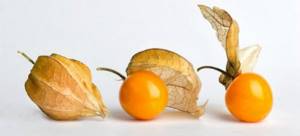
Physalis fruits: beneficial properties
Perhaps the only reason why physalis has not become as widespread a vegetable as other nightshade crops - potatoes, tomatoes, peppers, etc., is the small size of its fruits .
Indeed, in its composition , beneficial properties and taste, physalis is in no way inferior to all the listed crops, and is even more unpretentious in care than tomatoes.
content of its berries is second to none, which makes this product especially valuable for making caviar, sauces, marmalade, candied jams and marinades.
Physalis fruits are used to produce citric acid, since they contain many acids: malic, oxalic, succinic, caffeic, tartaric, furolic, sinapic. juice also contains vitamin PP, physalin, and tannins.
Physalis is used in folk medicine as a means to remove heavy metals, cholesterol, and radionuclides from the body. Fresh fruits or juice of this plant helps with diarrhea, rheumatism, gout, liver and stomach diseases; used as a diuretic, anti-inflammatory and analgesic.
Contraindications to the use of physalis
The fruits contain alkaloids that impair the taste, imparting bitterness. Because of this, it is not recommended to use physalis for pregnant women and young children, as well as people prone to allergic reactions. Only ripe fruits, where the amount of alkaloids is reduced, should be eaten. People with high stomach acidity should not eat berries due to their high content of citric acid. If you are hypersensitive to substances contained in the fruit, nausea and itchy skin may occur. In such cases, the use of physalis is contraindicated.
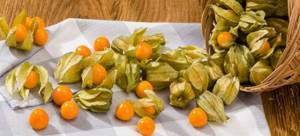
It is regrettable that official medicine underestimates the medicinal properties of physalis berries. It is possible that medicinal products made from fruit extracts would benefit many people!
Features of cultivation
Caring for physalis is not difficult, since the culture is very unpretentious. The plant prefers light, fertile soils and a sunny place, although it tolerates partial shade well. In the early stages of growth, it is necessary to protect the bushes from low temperatures. Strong plants do not need protection. The crop does not like strong humidity, so watering once a week is enough and can only be increased during dry periods. When fruits begin to set on the bush, irrigation is stopped altogether.
Reproduction
Physalis is grown from seeds by seedlings or propagated by dividing rhizomes. In mid-March, the seeds are sown in containers in a moist mixture of peat and perlite. Seedlings need to be provided with a lot of light and a relatively high temperature of 20-25 ̊C. Containers can be covered with clear film or plastic to ensure high humidity. Germination takes two to four weeks.
Once the sprouts appear, the film can be removed. When the seedlings have 3 leaves, they are picked and planted in separate pots 7-10 cm in diameter. Sprouts are grown in bright, diffused light, moderate soil moisture and a temperature of 17-20 °C. The less light, the lower the temperature should be. The culture is sensitive to low temperatures, so it is planted in open ground after the last frost at a distance of 30 cm from each other for small species and 60-90 for tall ones.
Description and characteristics of physalis
The name “physalis” is of Greek origin and means “bubble”. Its homeland is South and Central America. Then the plant was brought to North America, and from there further, all the way to Europe. The French called physalis a “flower for pregnant women.” If a man was ready to become a father, he gave his companion a bright bouquet of physalis “lanterns”.
The plant belongs to the Solanaceae genus and includes about 120 species. Physalis ornamental is a perennial. It is unpretentious, can tolerate low temperatures, and growing it is not difficult. It can reproduce by self-sowing, so it is enough to plant it once on the site.
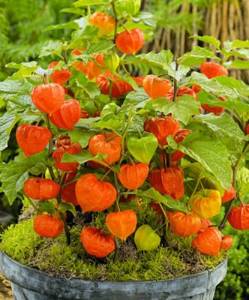
Decorative physalis is used to decorate the site
There are myths and legends about decorative physalis. Here is one of them. Long ago, a huge dragon swallowed the sun. The world has fallen into darkness. Without light and warmth, all living beings began to die. Then one brave young man decided to fight the monster and defeat him at all costs. Setting out on the road, the hero took with him a small lantern that illuminated his path. The young man found the dragon and challenged him to a fight. A difficult battle ensued, the dragon was killed, and the sun was freed. And in the first moments, when the life-giving light poured over the earth again, it was so bright that the hero covered his eyes with his palm, and the lantern fell to the ground. But it did not break into fragments, but into many bright red lanterns hanging from the stems. This is how physalis appeared in the world.
Orange Lantern Parade
- VK
- Youtube
When the green pericarps of the common physalis (Physalis alkekengi) turn bright orange, the garden is transformed, filled with warm light and energy. These amazing shrubs stand out quite clearly among other plants. Their unusual inflorescences, reminiscent of bubbles, shine in the rays of the evening sunset so that it seems as if someone has lit many small lanterns. In fact, we are talking about one of the plants that is unpretentious and unique in its use, which is highly valued by both florists and simply those who like to decorate the table beautifully and originally. Since dry lantern cups of physalis retain their shape and color for months, it is practically indispensable when composing winter bouquets.
The original type of fruit has given rise to many funny names, including bubble or Jewish cherry, sleepy grass, “Chinese lanterns,” “Mexican tomato,” and sleepy dope. The scientific name physalis comes from the shape of the flower calyx surrounding the round fruit, and comes from the Greek “physao”, which means “swollen”. Even in the Viennese Dioscorides, which was most likely created somewhere in 359. BC, a very similar fruit called "Physalis alkekengi" is described and depicted. It is curious that this Byzantine manuscript also indicates the Greek synonym for physalis “halikàkkabon”, which roughly translates to “pebbles”.
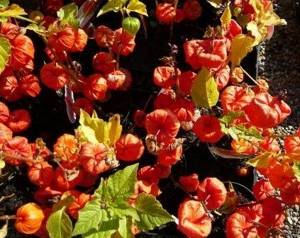
Physalis are annuals in our area, but in the tropics they are perennial herbaceous plants reaching up to 2 m in height. At the end of flowering, the calyx of the flower grows greatly and forms a paper-thin cover, shaped like a bubble. As the fruit ripens, the color of the calyx changes from green to orange and bright red-orange. Inside this natural parchment shell there is a round, orange berry the size of a cherry. The pulp of the physalis fruit consists of 15% soluble dry matter - mainly sugar - and is rich in organic acids, pectin, phosphorus, iron, provitamin A, vitamins B and C. A number of physalis species produce edible fruits. Their refreshing, slightly sweet and tart taste is reminiscent of a mixture of pineapple, coconut, kiwi, passion fruit, raisins and gooseberries.

There is no clear opinion about the origin of physalis, the genus of which includes about 100 species. Some consider its homeland to be South America, others are of the opinion that physalis comes from Japan or China. Together with tomatoes, eggplants, paprika and potatoes, physalis belongs to the large nightshade family. Some types of physalis have taken root in Europe. The most widespread in the wild is Physalis vulgaris, with straight and branched branches up to 40-60 cm high and long-petioled, sparsely pubescent, ovoid leaves. From June to July, physalis blooms with inconspicuous white or yellowish flowers. But when the ovary forms, a fruit-berry appears, enclosed in a shell similar to a paper Chinese lantern. The fruits of this species are unsuitable for consumption due to their bitter taste. Common physalis is grown as an ornamental plant in gardens, front gardens, near a pond in a sunny or shady place. It needs loose and humus-rich soil. Decorative physalis grows quickly, so in order to avoid crowding, the plant must be given enough space and the stems must be lifted from the ground, otherwise fruiting will be very poor.

In autumn, when the lantern cups of physalis acquire a bright orange-red color, they can be cut for bouquets. Just remember to remove dried leaves. Physalis branches look very beautiful and impressive in dry bouquets and Christmas wreaths. And with a garland of orange lanterns you can decorate a festive table, and even doorways.
As a vegetable crop, vegetable or Mexican physalis (Physalis ixocarpa) with large fruits, pubescent or raisin physalis (Physalis pubescens L.) with an exquisite taste, pronounced fruity aroma and pineapple flavor, and Peruvian physalis (Physalis peruviana L.), whose fruits are grown In terms of sugar and acid content, they are close to garden strawberries. There are not so many varieties of physalis, but they still exist. Thus, in the USA, the varieties “Giant Poha Berry” and “Golden Berry” have been described, which in the future will certainly win their place of honor in the world market. The tiny variety "Kosak pineapple" (bot. Physalis cf pubescens) captivates with its intense pineapple aroma, just like the variety "Grüne Mexikanische Tomate" (green Mexican tomatoes), also called "Tomatillo", with fruits the size of a walnut, depleting sweetish aroma. Physalis fruits are eaten raw or canned. They are added to fruit salads, yoghurts, or made into tender jam. Desserts and sweet dishes are decorated with yellow fruits. Their slightly sour taste is perfectly complemented by the delicate bitterness of chocolate. Physalis fruits can be dried and used as raisins. The main thing is to store them in a dry place, otherwise the physalis raisins will quickly become moldy.

Physalis peruviana
If you have already decided to acquire a unique plant - physalis, you will not be disappointed. In its biological properties, physalis is close to tomatoes. For it, as for tomatoes, cucumbers, onions, cabbage, and perennial herbs are considered the best predecessors. From year to year, in March, physalis seeds are sown in the ground or seedlings are planted at the end of May. In regions with a mild climate, physalis is able to winter in open ground. At the same time, you should not prune the bush in the fall, but simply cover it with brushwood. Next spring, the bush is cut in half.
Do you want to be sure that the plant will not suffer over the winter? Sow physalis seeds directly into a flower pot. The bush develops equally well both in a tub and in open ground. Physalis in a pot consumes a lot of water in the summer. Since garden soil in pots will leach over time, physalis will need to be fertilized every four weeks. At the same time, physalis planted in open ground does not need fertilizer.
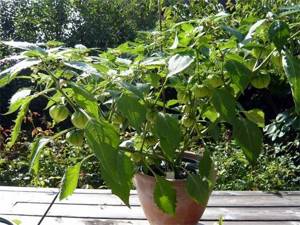
For a safe overwintering of a plant growing in open ground, you can move it into a flower tub or box. To do this, the bush is trimmed a little in the fall, dug up and transplanted into a container with garden soil. Move the physalis indoors before the first frost. But it is better to prune dried parts of the plant only in the spring, and cut them only by half. For overwintering, it is best to choose a cool and not too dark room. And don’t forget to water the plant from time to time, by the way. In winter, physalis does not need fertilizer. It may be that in the fall your physalis still displays unripe fruits. Feel free to move it indoors; as a rule, the fruits ripen there. In spring, the physalis bush is pruned and placed in a sunny place in the garden or on the terrace. The plant can also be transplanted into a flowerbed, where it will further develop, delighting us with its bright lanterns.
Translation: Lesya Vasko especially for the gardening internet portal
Publication date: November 16, 2010
comments
Lesya Vasko
If you notice an error, select the required text and press Ctrl+Enter to report it to the editors
Comments:
There are no comments yet, you can add your own comment. For this you need to register or log in.
Authorization
You have entered an incorrect login/password
adding a comment
Useful articles
- Polycarbonate greenhouse
Types of decorative physalis
For decorative purposes, the most commonly used species, which we call “Chinese lanterns,” is Physalis vulgaris, which has two varieties:
- Physalis Franchet is a perennial plant named after the French biologist Adrien Rene Franchet who first described this species. It grows up to 90 cm in height, has a creeping rhizome and smooth, erect stems. The diameter of the “flashlight” is up to 7 cm;
- Physalis Alkekengi is also a perennial with pubescent, often semi-recumbent stems. The fruit calyxes of this species are small - from 2 to 4 cm, with “lanterns” of yellow, orange or red color.
Both plants are used not only as decoration for flower beds, but also as natural dyes. For decorative use, Physalis Franchet is of greater value.
There is another variety of decorative physalis - this is physalis Longifolia. The height of the plant can reach two meters. This is the only species that is valued for its unusual flowers. They have an interesting feature: they open at noon and close 4 hours later. The “lanterns” of this physalis have a nutty hue and pronounced ribs.
Gallery: types of decorative physalis
LiveInternetLiveInternet
Physalis decorative. Chinese lanterns.
The correct name for Chinese lanterns is Physalis alkekengi or Physalis francheti. The name of the plant is given by the name of its first researcher, the French botanist Adre René Franchet. The homeland of this type of physalis is distant Japan. It has been grown as an ornamental crop since 1894. Ornamental physalis is a perennial herbaceous plant of the Solanaceae family of the genus Physalis with a woody stem at the base. Unlike the vegetable and berry physalis, the decorative fruits are inedible. A distinctive feature of the decorative physalis is the bright orange-red sheath enveloping its fruit, reminiscent of a paper Chinese lantern. Its diameter in some varieties reaches 6-5 cm. This calyx (calyx) is the main decorative decoration of the plant. And its white flowers are inconspicuous and very small, no more than 3 cm. Physalis blooms at the beginning of summer. After it, green cups form on the physalis, in which the fruit ripens. They are the decoration of the plant at this time. At the beginning of autumn, the physalis fruit fully ripens and appears in all its glory. The color of its covers at this time becomes bright orange. There are various cultivated varieties of ornamental physalis, differing mainly in the height of the plant and the size of its bright cups. Tall Franchet physalises can grow up to 90 cm, and miniature patio physalises are no higher than 30-45 cm. The photo shows the ripening cups of decorative physalises.
Growing Physalis.
Physalis Franchet is the most frost-resistant type of physalis. It is able to withstand sub-zero temperatures of 30 degrees C. In addition, this species grows on almost any calcareous soil. You can often find its wild thickets in abandoned gardens. In order for the physalis cups to be bright and large, it is better to place physalis in sunny places with fertile, permeable soil. When growing, no plant formation is required. Only tall varieties of physalis are tied to keep its branches slender for the winter bouquet. Caring for physalis is simple: weeding, loosening, watering once a week, in dry summers - once every two days, liquid fertilizing 2 times a month. In order for the decorative physalis lanterns to ripen before the onset of cold weather, at the end of August the tops of the physalis are pinched. And so that physalis does not degenerate, once every 6-7 years its rhizomes are divided and planted.
Decorative physalis reproduces by rapidly growing new shoots from shallow creeping rhizomes. The growth of roots is so fast that often in flower beds it is necessary to limit their space by digging plastic, iron or slate barriers into the ground to a depth of 30 cm. New shoots with part of the rhizome are ideally suited for the propagation of physalis. They are dug up in spring or autumn and planted at a distance of half a meter from each other. This is the easiest and most convenient way to propagate physalis. Physalis can also be propagated by cuttings and seeds.
Propagation of physalis by cuttings and seeds.
Physalis cuttings are carried out in July, cutting off the tops of the stems with 2-3 developed internodes. The cuttings are planted in loose soil, buried halfway, watered and kept for some time under a film with a ventilation hole. In sunny weather, shade the cuttings and make sure that the soil under them does not dry out. When the physalis cuttings take root, the film is removed and the plants are cared for in the usual way. For seed propagation, physalis is sown directly into the ground in May or late October. It is better to sow in buried bowls or pots with flower soil, since the physalis root system grows quickly. From pots it will be easier to replant it to a permanent place without fear of damaging the roots. In addition, sowing in bowls with flower soil will protect physalis from weeds, with which it can be confused with direct sowing in the ground. Grown plants are planted in a permanent place according to the scheme recommended for each variety. You can sow physalis at home in March-April under glass before germination. It is better to do this also in pots or plastic cups. As physalis grows, the pots are changed to larger ones. Germination of physalis seeds occurs at a temperature of +19-20 degrees C. To prevent seedlings from stretching, they are kept in a cool place. Caring for seedlings consists of moderate watering with warm water and fertilizing. Seedlings are planted in the ground in the second ten days of May at a distance of half a meter. Landing is carried out in the evening or morning, or in cloudy weather. In sunny weather, seedlings are shaded. Until the seedlings fully take root, the plants are looked after especially carefully.
Physalis in garden and home design.
Physalis is planted in groups, in mixborders, in containers and hanging pots. Miniature physalises are often grown as indoor plants, timing the peak of their decorative value around Christmas. The bright lanterns of Physalis Franchet are the latest decoration of the autumn garden and delight us with their life-affirming color. Left in the garden until spring, they peek through the snow like a scattering of tangerines, giving us new impressions and emotions. Physalis Franchet is most widely used as a dried flower in winter bouquets that decorate our homes until spring. To keep Chinese lanterns decorative throughout the year, they must be properly dried. To do this, cut off the physalis stems with fully colored cups. Unripe calyxes will remain dull after drying. Remove the leaves from the physalis stems. If you use physalis sprigs to make compositions, dry each sprig separately. If you want to create a chic bouquet of physalis, collect it immediately before drying, tying 5-7 branches. Dry physalis in the shade in a ventilated area in an upright position. Elegant bouquets made from physalis will decorate the interior of any apartment or house, bringing the aroma of summer into it.
source
Decorative physalis in floristry and interior design
Decorative physalis is not grown for its flowers, because they are small and inconspicuous. This plant attracts attention in the fall, when the capsule fruits grow and become orange or bright red.
Most often it is used in winter bouquets, supplemented with other dried flowers: gomphrena, lunaria, helichrysum, statice, craspedia, etc. Decorative physalis is also good for creating various compositions, floral paintings, wreaths.

